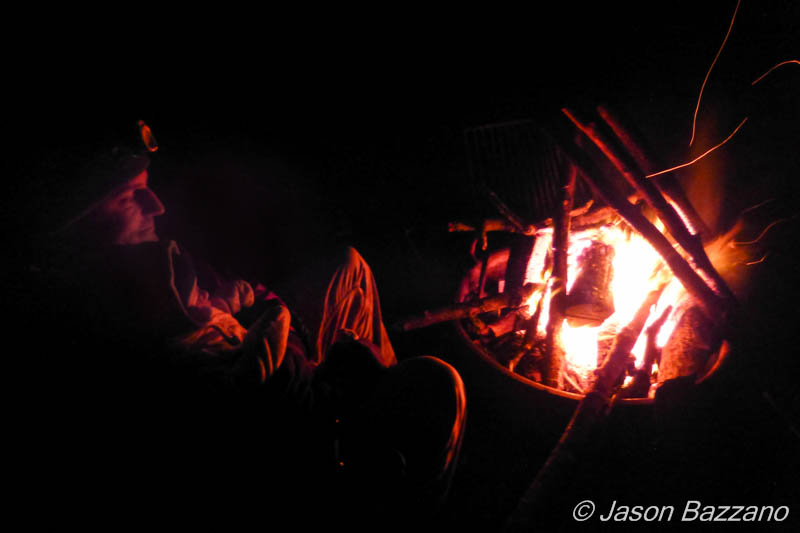I love camping. For me, it’s a chance to relax, hike around, and check in with all the cool stuff happening in nature that I’ve been missing out on. And, of course, it’s time to have some fun with photography, too.
Luckily, I married someone who shares many of my interests, including spending time outside, and before we had our daughter we went camping all the time. The big question when our daughter was born was how would the little one fare out in the woods? And would camping still be fun for us?
I’m happy to report that our little girl is already an expert camper, and we still have loads of fun outdoors. In fact, baby camping is in many ways even more fun: being on hand the very first time our daughter sees, for example, a northern red-legged frog – and witnessing her reactions – is pretty awesome.
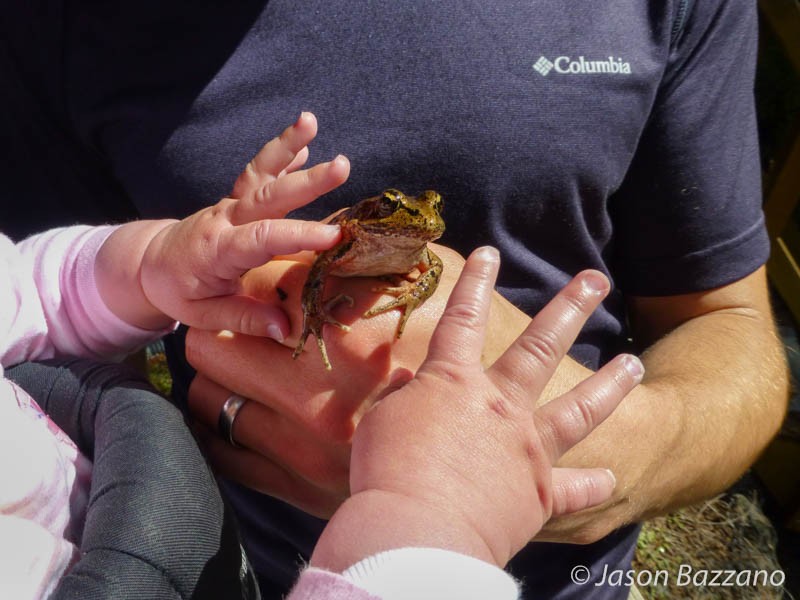
After our daughter’s first birthday a few weeks back I went over my calendar and tallied up the number of nights that she had spent camping in her first year: forty-two nights. Not bad – with over 10% of her entire life spent camping, I feel like I’m doing a reasonably decent job at being a father.
Now, whenever we go on a camping trip, our little one already knows it’s going to be good fun: full of dirt to play in, pine cones to gnaw on, insects to chase, and amphibians and reptiles to squeeze (gently, of course). She has turned out to be an exceptionally positive outdoorsbaby, and her enthusiasm for the natural world (and – to be honest – most everything else, too) is infectious.
So did we just luck out with a camping natural? Well, it’s hard to say anything conclusive with a sample size of one (she’s our first), though I suspect that our approach to family camping in general was certainly helpful. Here, I’ll discuss a number of strategies that I think are worth mentioning for those of you who are interested in camping with your little ones (and if you have kids and you aren’t camping with them, what the heck are you doing, anyway? Hogging all the camping fun for yourself while they stay at home with a sitter?)
What kind of camping are we talking about, here?
Just to be clear, we generally partake in easy-peasy dispersed car camping (camping outside of designated campgrounds) in National Forest Service (NFS) land or Bureau of Land Management (BLM) land.
The great thing about dispersed camping is you find a site that matches whatever it is that you’re looking for – you don’t need to shoehorn your camping experience into a handful of pre-established sites. Furthermore, you don’t have to make any advance reservations, and of course the campsite is never crowded, no matter what time of year you go (indeed, you’re the only ones there). And it’s free!
Usually, we’ll decide in advance on a larger region where we’d like to spend some time, and then we’ll scout around until we come across a site that possesses whatever characteristics (stream, dense forest, open meadow, etc.) we happen to be in the mood for. Even the act of searching for a campsite is fun, exploring the landscape and expanding your mental map of the region.
While similarly easy from a logistics standpoint, I’ve found car camping at established campgrounds to be a hit-or-miss type of affair – and usually it’s a miss. If it’s in a good location or is otherwise especially desirable, at most times of the year you’re usually going to find yourself in a noisy tent city – a kind of sub-suburbia, where the houses are closer together and the walls are much thinner. However, in densely populated areas these are sometimes your only options (i.e., there’s just not a lot of NFS or BLM land around).
For those of you who are skeptical about car camping in general: yes, it’s true, car camping is not as glamorous as backpacking. You’re restricted to front-country locations (and all that that implies), as many remote regions are simply inaccessible without hiking in.
But here’s the good news: there are still some great spots that you can access with car camping, and it’s a piece of cake to bring a baby. You don’t need to bring tons of gear (though you can bring some luxury items [say, a black light array] if you feel so inclined), and it’s so easy that you can do it all the time at the drop of a hat – which means that your kid will be primed and ready for the day that you decide that you’re ready to take them on their first backpacking trip.
Baby’s first camping trip.
The very first camping trip you take your kid on can be a little daunting. Just try and be reasonably well-prepared, and remember that nobody is going to die if you forget something. Once you’ve trialed and erred for a bit and figured out what’s important and what isn’t, you can dial back the preparations substantially.
Our first trip was when our daughter was about 3 months old. We took her out to the coastal mountains of Oregon at the end of December. In order to simplify matters and reduce travel time, we opted for an established campground that wasn’t too far from home; we figured that we would probably have the whole place to ourselves at that time of year (we were right).
It was clear and cold – the temperature was in the low 20s (Fahrenheit), which is about as cold as it gets in western Oregon. We wrapped our daughter up in so many layers that her arms stuck straight out and she looked like an overstuffed teddy bear.
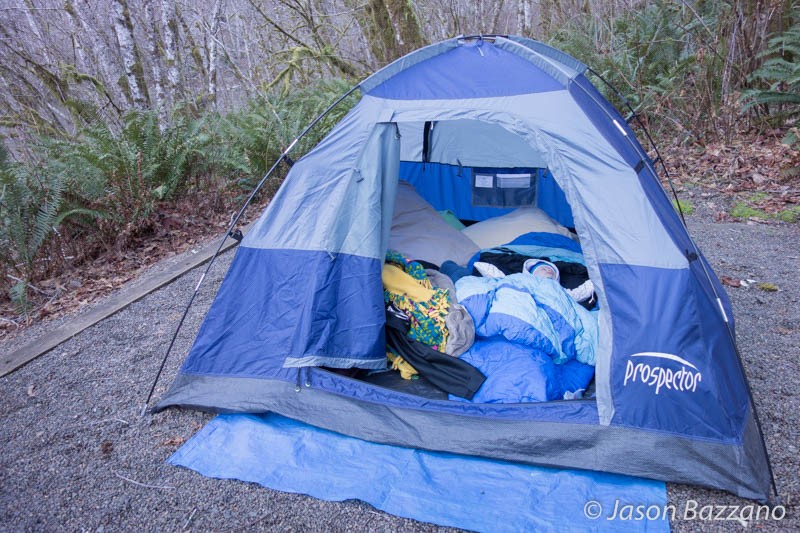
We poked around by the river, made a campfire, and had some camper pies. We took it easy and had a good time with it. Our little one didn’t sleep too well that night (and therefore, neither did we), though despite the sleep deprivation, we rallied for a hike the following day – crunching through the needle ice and showing our little one her first icicles.
After that first trip, things got way easier. We learned what worked and what didn’t, and we simplified and codified our preparations. The parameters changed as our daughter grew, and we in turn adapted our strategies to match.
Tips for camping with a baby.
Below, I’ve compiled a short list of some of the most useful tools we use when camping with our baby, and organized them into general categories.
Food:
Make sure that feedings (both for babies and for parents!) are reasonably on schedule. Nobody in your party is going to have any fun if someone is hangry. Just because you’re running behind schedule on your way out to the site doesn’t mean you should skip lunch. If you’re running way behind (and actually, you probably will be) just find somewhere else to camp that’s nearby – you can get to the final destination the following day. Incidentally, we’ve stumbled across a number of fantastic campsites by doing this.
Shelter:
Having a large, comfortable, dry space available is HUGELY important. If it’s raining outside, do you have a place where you can comfortably hang out and play with your kid between hikes?
A four-person dome tent for two parents and a baby is the perfect size. They have a nice, efficient, rectangular floor plan, and they’re fast and easy to set up. Just make sure that the one you use is reasonably weatherproof and made of decent-quality materials. We went camping in Olympic National Park for five rainy days back in March and our borrowed tent was not up to the task. After our trip in the Olympics, we bought a solid tent that resembles this one.
Sleep:
It’s amazing how much more complicated a day becomes when a baby misses a nap. Even though you’re away from home, it’s important that your kid maintains a semblance of their normal nap schedule. Timing long car rides to coincide with nap time often works well.
At the campsite, however, matters can be challenging (baby wrangling is so much easier when the kid is restrained in a 5-point harness). Before our daughter was able to roll over, we used a basket similar to this that worked great. We would put her in the basket inside the tent for a nap (make sure the tent is in the shade!). Once we were out of view (blocked by the tent), she usually slept well. Now that she’s more mobile, we put her in a collapsible baby cage (a Pack ‘n Play) inside the tent or under a canopy.
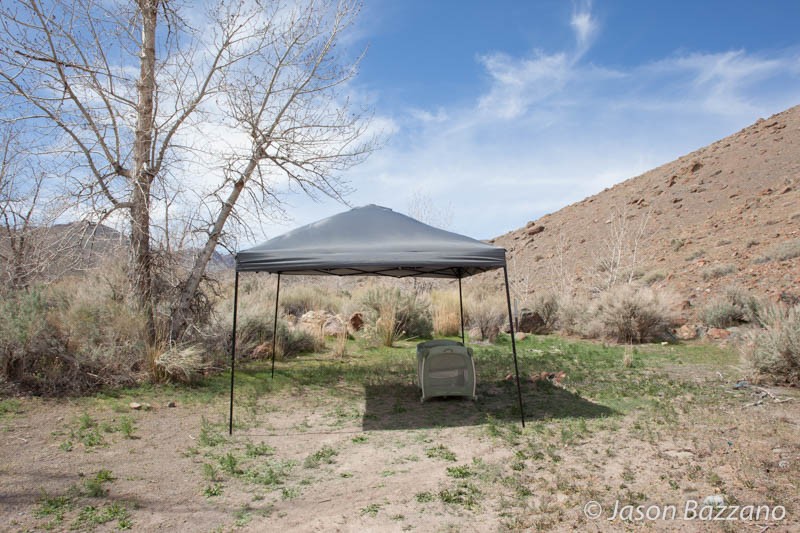
Diapers:
Babies generate a remarkable amount of waste. Over the course of a 3 to 4-day camping trip, they’ll generate a mass of diapers that exceeds their own body weight. On shorter camping trips (under, say, five days) we use a system of 2 large plastic-lined cloth bags, in addition to a typical diaper bag with all the changing gear. One big bag has clean diapers, the other has dirty diapers. We’ll restock the diaper bag a couple times a day. It’s a simple system that works well. After five or six days we typically switch to disposable diapers, since we’ll have run out of cloth diapers by then.
Special considerations for spending time outdoors:
Don’t be afraid to let your kid get dirty and chew on things as they explore the landscape. It will be a lot more fun for your kid if you don’t keep taking away his or her newly found toy. Every time you see your child put something in his or her mouth, ask yourself if it’s likely that they will seriously injure themselves. Usually it’s not the case. Pinecone in the mouth? No big deal. An ant? Some ants are actually quite tasty. Sharp stick? Consider trading it for a blunt stick.
When you’re hiking around, make sure you have a baby carrier that both you and your baby find comfortable. Hikes will be a lot more enjoyable. Furthermore, when you need a break from active supervision, strapping the kid to your person can be quite convenient.
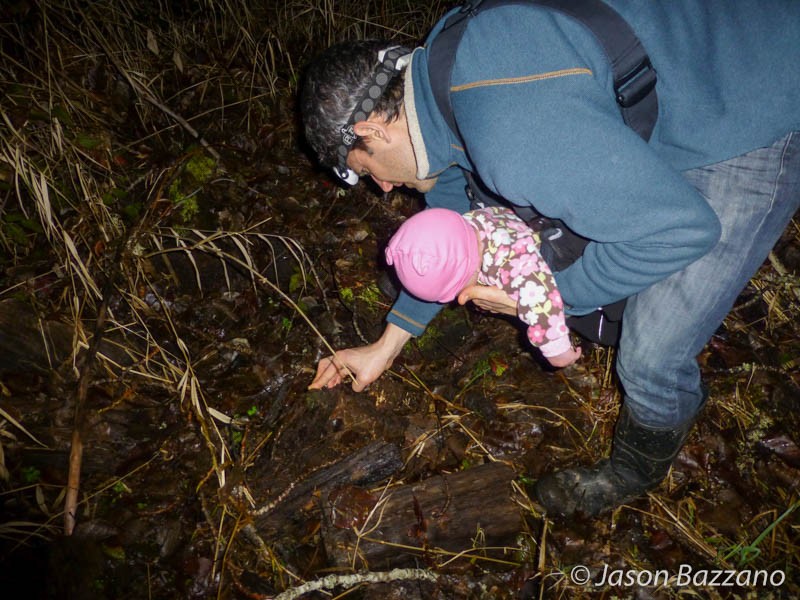
Going out in the sun? You must cover your kid up! Footed pyjamas and big floppy hats are ideal for this.
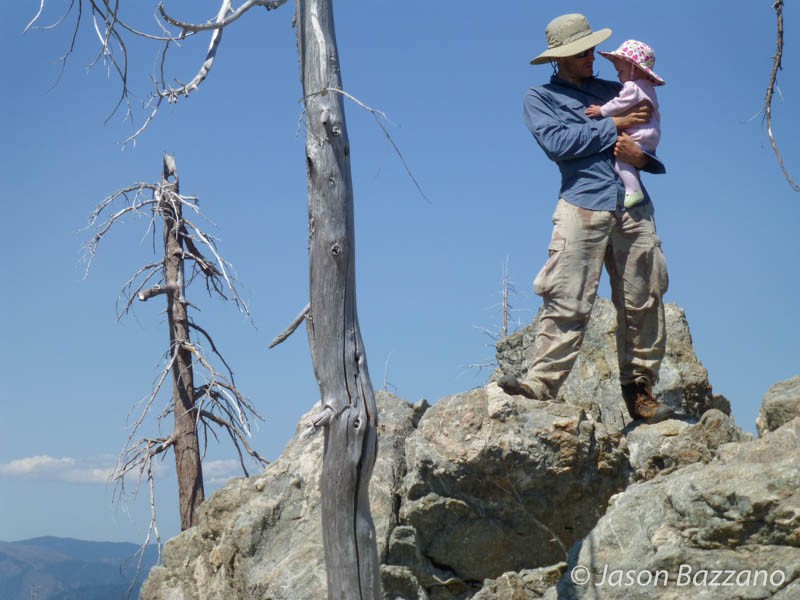
Going out in the rain? Giant umbrellas are the best thing ever. No need for fancy rain jackets here – one simple tool keeps everyone dry and happy.
Attitude:
Keep a positive attitude! If you’re having fun, show it! If you’re not… well, you’re doing something wrong, then. Remember, babies take their cues from you. If you’re haggard and grumpy, they will be, too. Make sure to correct a deteriorating situation before it’s too late to recover. This means that you’re going to have to make sure you’re communicating effectively with other adult members of the party (something you should be doing anyway, of course).
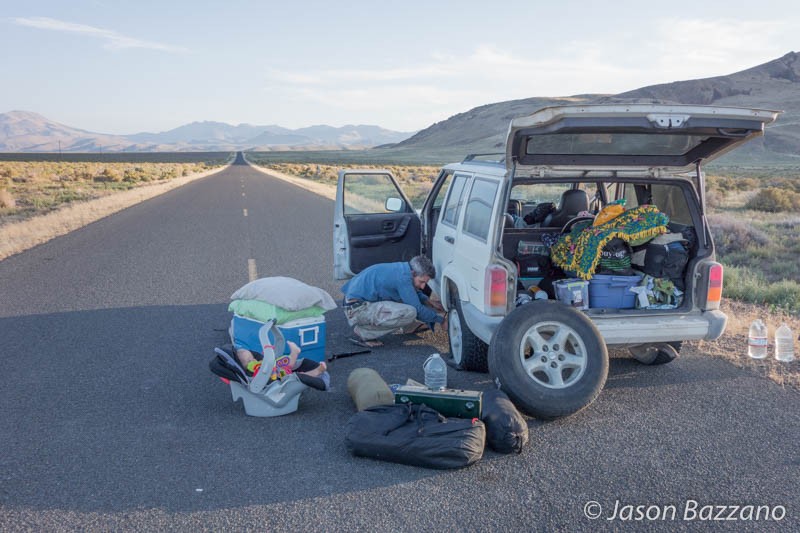
Concluding remarks.
I certainly don’t pretend to know everything there is to know about parenting – indeed, I’ve only been at it for little more than a year. However, I feel strongly that children should be raised with an appreciation of the natural world, and there’s no better way to do that than taking them camping. And it’s a heck of a lot of fun.
Do you have camping strategies that work for more than one baby? Or camping with only one parent and a baby? Or perhaps backpacking with a baby? I’d love to hear about them in the comments below!

